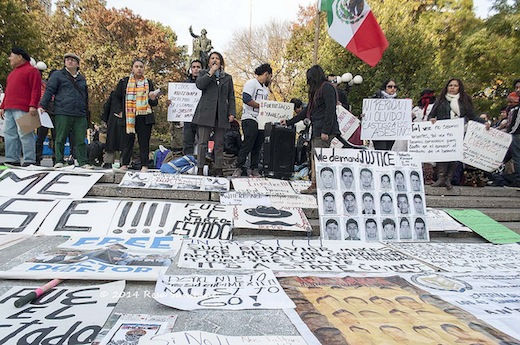
Mexico may be facing a political situation without precedent since the Revolution of 1910-1920. Massive protests are roiling the country while a major corruption scandal is disrupting trade relations with China. Calls for the president, Enrique Peña Nieto, of the Revolutionary Institutional Party (PRI) to resign are being heard not only on the street but within the legislature as well.
On Friday, Mexican Attorney General Jesus Murillo Karam announced to a skeptical nation that remains found submerged in a river in the southern state of Guerrero are probably those of 43 teacher training college students from Ayotzinapa who were violently abducted in the city of Iguala on the night of Sept. 26-27. However, the parents of the missing students refuse to take this as final unless an independent investigation confirms that these were their sons.
Until then they will not retire their battle cry: “They took them away alive, we want them back alive”.
Why the skepticism? The suspicion is that the government wants to represent the attack in Iguala as an “isolated incident” and the fault only of some local politicians and corrupt police. More and more Mexicans, however, see the ultimate responsibility as lying much higher up, in an entire system people are beginning to call “narco-gobierno” (“drug trafficker government”).
The official story is that the mayor of Iguala, Jose Luis Abarca, of the nominally leftist Democratic Revolutionary Party (PRD), and his wife, Maria de los Angeles Pineda, ordered the attack on the students for purely local reasons. The students were in Iguala to seek funds for transportation to events in Mexico City commemorating the 1968 massacre of Tlatelolco Plaza, where several hundred students were murdered by security forces. Ms. Pineda’s brothers are in the leadership of a regional criminal gang, Guerreros Unidos (United Warriors), and local police were supposedly ordered by Ms. Pineda to cooperate with the gang to teach the students a lesson. According to Mr. Murillo Karam, they were captured by police, handed over to the gangsters, and murdered, their burned and dismembered remains thrown into the San Juan River.
While searching for the students, investigators came upon numerous mass graves filled with dismembered and burned bodies. These, they announced, were not the 43 missing students. But then who were they? Everybody in Mexico knows that there are hundreds of such graves. Since President Felipe Calderon of the right wing National Action Party (PAN) decided to unleash the military in the cities as part of the U.S. promoted and financed “War on Drugs,” the number of missing has risen beyond 24,000, and many more are known to have been killed.
There has been violence in Guerrero for a long time, and it has involved student teachers (normalistas) before. In 2011, two student teachers from Ayotzinapa were murdered by police. The army has fought skirmishes with guerrilla forces in Guerrero for several decades. A legendary guerrilla leader in the Guerrero mountains, Lucio Cabañas, started out as a normalista teacher from Ayotzinapa. Abusive landowners, crooked political bosses and agents of multinational mining corporations looking to loot Guerrero of its resources fear the teachers. In neighboring Oaxaca in 2006, a revolt involving teachers was never fully quelled.
The teachers in the normalista system are recruited from the poor farm population, including from the many non-Spanish speaking indigenous groups. They stay on in these poor communities, providing not only educational services, but also, frequently, leadership in struggles for social justice. When Enrique Peña Nieto was elected in 2012, he immediately set in motion “reforms” of the petroleum industry, of labor law and of the educational system, which are designed to make Mexico even friendlier to multinational corporations than it already is. His educational reforms were seen as being directed against the normalistas. So, militant action by the grassroots was expected. This may be why the Ayotzinapa students had to be “taught a lesson.”
The protesting teachers, students and their allies have taken over town halls all over Guerrero. On Sunday, during a huge demonstration in Mexico City, protestors set fire to one of the massive wooden doors of the National Palace.
Meanwhile, a huge new problem faces President Peña Nieto, whose government has been negotiating with China to build a high-speed rail system between Mexico City and Queretaro. Over the weekend, it was revealed that a property that the president’s wife, Angelica Rivera, has said will be their luxurious home after his six-year presidency ends, turns out to be registered under the name of the Higa group, a consortium of companies who stand to make millions from the train project. Facing this mounting scandal on top of the rebellion over the Ayotzinapa issue, the Mexican government abruptly cancelled the bullet train deal, leading to angry objections from China.
Demands are getting more radical and coming from within ruling institutions as well as the street.
Last week, Senator Layda Sansores San Roman, of the Labor Party (PT), electrified the Mexican Senate with a speech in which she damned the whole political and military establishment as corrupt and linked to drug trafficking, and ended by joining the demand that President Peña Nieto resign so that new elections can bring in leadership that will really represent the people.
Photos: New Yorkers hold a solidarity rally, #WeAreAllAyotzinapa, for the 43 missing Mexican students, Nov. 8. (A Jones/CC/Flickr)










